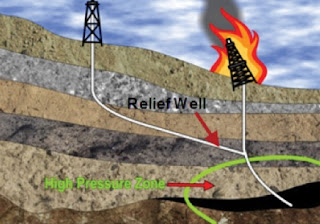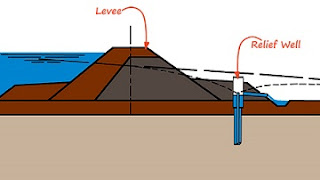 |
| Using a relief well to kill a blowout |
Oh, sure, Laukkonen started off on the right track (who wouldn't?), explaining in his very first sentence that,
"When a well experiences a blowout, which is a sudden and uncontrolled expulsion of natural gas or crude oil, relief wells are one way to regain control."
|
Unfortunately, it only took one more sentence for Jeremy to display his ignorance of his topic:
"The relief well is typically drilled so it will intersect with the blowout, either to relieve pressure or block the reservoir." No, Jeremy, a relief well is drilled to intersect the wellbore (a blowout is a condition, not a thing). And no exploration company ever wants to "block the reservoir" – they want to be able to get the hydrocarbons out, after all. Jeremy would have been better off to say something like "plug the path of the hydrocarbons" or some such.
|
Jeremy later told his readers that,
"Relief wells are one of the primary means of defense against blowouts if the BOP and other safeguards have failed."
Sorry, Jer, relief could be considered a "means of defense" only in the sense of a quarterback tackling a safety to prevent a pick-six in a football game. They're last-ditch efforts to control ("kill") the well; to halt the free flow of hydrocarbons that is a blowout. They are definitely not "primary." As for Laukkonen's claim that,
"In some cases a relief well can be drilled in advance of any problems..."
 |
| Relief well for levee |
...such wells are unknown in the petroleum industry, where they could entail an expense in the tens or even hundreds of millions of dollars. Relief well drilling "in advance" is a practice of the construction industry, particularly in very large-scale projects such as dams and levees (see image at right). Jeremy mumbled something about this in his final paragraph, averring that,
"When the ground becomes saturated with water, the wells can be used to draw some of it out."
Once more, his ignorance is on display: what Jeremy does not understand is that such wells are drilled to relieve pressure on confined aquifers, which are continually saturated – not occasionally as he seems to suggest.
As is so often the case, Laukkonen's framework is more or less accurate. Where he failed, as did so many of his fellow Dumbass of the Day awardees before him, was in papering over that framework with misused terminology and misconception as a result of ignorance of the topic and scanty research. Feh.
SE - OIL
No comments:
Post a Comment